Aminahassan001
On this page, you find all documents, package deals, and flashcards offered by seller AMINAHASSAN001.
- 456
- 0
- 19
Community
- Followers
- Following
475 items
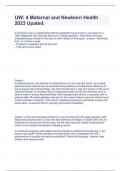
UW: 4 Maternal and Newborn Health 2023 Upated.
UW: 4 Maternal and Newborn Health 2023 Upated.A practical nurse is collaborating with the registered nurse to form a care plan for a client diagnosed with placenta previa at 33 weeks gestation. What does the nurse anticipate being included in the plan of care? Select all that apply. -answer - Nonstress test 1 or 2 times a week - Prepare for cesarean birth at any time - Type and screen blood Explain: In placenta previa, the placenta is implanted over or very near the ...
- Exam (elaborations)
- • 11 pages •
UW: 4 Maternal and Newborn Health 2023 Upated.A practical nurse is collaborating with the registered nurse to form a care plan for a client diagnosed with placenta previa at 33 weeks gestation. What does the nurse anticipate being included in the plan of care? Select all that apply. -answer - Nonstress test 1 or 2 times a week - Prepare for cesarean birth at any time - Type and screen blood Explain: In placenta previa, the placenta is implanted over or very near the ...
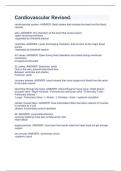
Cardiovascular Revised.
Cardiovascular Rovascular system -ANSWER. Body system that includes the heart and the blood vessels. atria -ANSWER. The chambers of the heart that receive blood. Upper receiving chambers -separated by interatrial septum ventricles -ANSWER. Lower discharging chambers. that function as the major blood pumps -separated by interatrial septum AV valves -ANSWER. Open during heart relaxation and closed during ventricular contraction tricuspid and bicuspid SL valves -ANSWER. Semilunar, ...
- Exam (elaborations)
- • 5 pages •
Cardiovascular Rovascular system -ANSWER. Body system that includes the heart and the blood vessels. atria -ANSWER. The chambers of the heart that receive blood. Upper receiving chambers -separated by interatrial septum ventricles -ANSWER. Lower discharging chambers. that function as the major blood pumps -separated by interatrial septum AV valves -ANSWER. Open during heart relaxation and closed during ventricular contraction tricuspid and bicuspid SL valves -ANSWER. Semilunar, ...
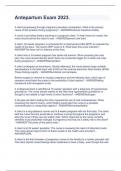
Antepartum Exam 2023.
Antepartum Exam 2023A client progressing through pregnancy develops constipation. What is the primary cause of this problem during pregnancy? - ANSWERreduced intestinal motility A nurse is providing dietary teaching to a pregnant client. To help meet iron needs, the nurse should advise the client to eat: - ANSWERspinach and beef. A client, 30 weeks pregnant, is scheduled for a biophysical profile (BPP) to evaluate the health of the fetus. The client's BPP score is 8. What does this score ...
- Exam (elaborations)
- • 13 pages •
Antepartum Exam 2023A client progressing through pregnancy develops constipation. What is the primary cause of this problem during pregnancy? - ANSWERreduced intestinal motility A nurse is providing dietary teaching to a pregnant client. To help meet iron needs, the nurse should advise the client to eat: - ANSWERspinach and beef. A client, 30 weeks pregnant, is scheduled for a biophysical profile (BPP) to evaluate the health of the fetus. The client's BPP score is 8. What does this score ...
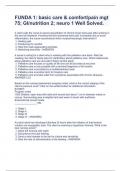
FUNDA 1: basic care & comfort/pain mgt 75; GI/nutrition 2; neuro 1 Well Solved.
FUNDA 1: basic care & comfort/pain mgt 75; GI/nutrition 2; neuro 1 Well Solved.A client calls the nurse to report exacerbation of chronic lower back pain after working in the yard all weekend. Knowing that this worsened back pain is probably due to acute inflammation, the nurse recommends which nonpharmacologic intervention? 1. Heating pad 2. Positioning for comfort 3. Rest from pain-aggravating activities 4. Stretching exercises - ANSWER3 A nurse is caring for a client who is meet...
- Exam (elaborations)
- • 16 pages •
FUNDA 1: basic care & comfort/pain mgt 75; GI/nutrition 2; neuro 1 Well Solved.A client calls the nurse to report exacerbation of chronic lower back pain after working in the yard all weekend. Knowing that this worsened back pain is probably due to acute inflammation, the nurse recommends which nonpharmacologic intervention? 1. Heating pad 2. Positioning for comfort 3. Rest from pain-aggravating activities 4. Stretching exercises - ANSWER3 A nurse is caring for a client who is meet...
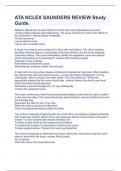
ATA NCLEX SAUNDERS REVIEW Study Guide.
ATA NCLEX SAUNDERS REVIEW Study Guide.Rifabutin (Mycobutin) is prescribed for a client with active Mycobacterium avium complex (MAC) disease and tuberculosis. The nurse monitors for which side effects of the medication? -answer Signs of hepatitis Flu-like syndrome Low neutrophil count Ocular pain or blurred vision A nurse in a medical unit is caring for a client with heart failure. The client suddenly develops extreme dyspnea, tachycardia, and lung crackles, and the nurse suspects pulmonar...
- Exam (elaborations)
- • 31 pages •
ATA NCLEX SAUNDERS REVIEW Study Guide.Rifabutin (Mycobutin) is prescribed for a client with active Mycobacterium avium complex (MAC) disease and tuberculosis. The nurse monitors for which side effects of the medication? -answer Signs of hepatitis Flu-like syndrome Low neutrophil count Ocular pain or blurred vision A nurse in a medical unit is caring for a client with heart failure. The client suddenly develops extreme dyspnea, tachycardia, and lung crackles, and the nurse suspects pulmonar...
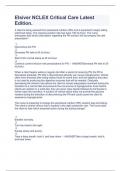
Elsiver NCLEX Critical Care Latest Edition.
Elsiver NCLEX Critical Care Latest EditionA client is being weaned from parenteral nutrition (PN) and is expected to begin taking solid food today. The ongoing solution rate has been 100 mL/hour. The nurse anticipates that which prescription regarding the PN solution will accompany the diet prescription? 1. Discontinue the PN. 2. Decrease PN rate to 50 mL/hour. 3. Start 0.9% normal saline at 25 mL/hour. 4. Continue current infusion rate prescriptions for PN. - ANSWERDecrease PN ra...
- Exam (elaborations)
- • 144 pages •
Elsiver NCLEX Critical Care Latest EditionA client is being weaned from parenteral nutrition (PN) and is expected to begin taking solid food today. The ongoing solution rate has been 100 mL/hour. The nurse anticipates that which prescription regarding the PN solution will accompany the diet prescription? 1. Discontinue the PN. 2. Decrease PN rate to 50 mL/hour. 3. Start 0.9% normal saline at 25 mL/hour. 4. Continue current infusion rate prescriptions for PN. - ANSWERDecrease PN ra...
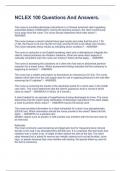
NCLEX 100 Questions And Answers.
NCLEX 100 Questions And Answers.The nurse is providing discharge instructions to a Chinese American client regarding prescribed dietary modifications. During the teaching session, the client continuously turns away from the nurse. The nurse should implement which best action? - ANSWER. The nurse reviews a client's arterial blood gas results and notes that the pH is 7.30 (7.30), the Paco2 is 52 mm Hg (50 mm Hg), and the HCO3 is 22 mEq/L (22 mmol/L). The nurse interprets these results as indi...
- Exam (elaborations)
- • 14 pages •
NCLEX 100 Questions And Answers.The nurse is providing discharge instructions to a Chinese American client regarding prescribed dietary modifications. During the teaching session, the client continuously turns away from the nurse. The nurse should implement which best action? - ANSWER. The nurse reviews a client's arterial blood gas results and notes that the pH is 7.30 (7.30), the Paco2 is 52 mm Hg (50 mm Hg), and the HCO3 is 22 mEq/L (22 mmol/L). The nurse interprets these results as indi...
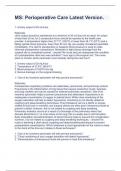
NCLEX 35 Page study guide
NCLEX 35 Page study guideIn delegation, nurses must take patients where there is... - ANSWEREvaluation Assessment Teaching Dont delegate what you can EAT Addison disease vs Cushings disease - ANSWERAddisions: down down down up down (hyponatremia, hypotension, decreased blood volume, kyperkalemia, hypoglycemia) Cushings: up up up down up (hypernatremia, hypertension, increased blood volume, hypokalemia, hyperglycemia) When do we hold potassium - ANSWERDo not give potassium without...
- Exam (elaborations)
- • 28 pages •
NCLEX 35 Page study guideIn delegation, nurses must take patients where there is... - ANSWEREvaluation Assessment Teaching Dont delegate what you can EAT Addison disease vs Cushings disease - ANSWERAddisions: down down down up down (hyponatremia, hypotension, decreased blood volume, kyperkalemia, hypoglycemia) Cushings: up up up down up (hypernatremia, hypertension, increased blood volume, hypokalemia, hyperglycemia) When do we hold potassium - ANSWERDo not give potassium without...
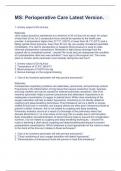
MS: Perioperative Care Latest Version.
MS: Perioperative Care Latest Version.1. Urinary output of 20 mL/hour Rationale: Urine output should be maintained at a minimum of 30 mL/hour for an adult. An output of less than 30 mL for 2 consecutive hours should be reported to the health care provider. A temperature higher than 37.7°C (100°F) or lower than 36.1°C (97°F) and a falling systolic blood pressure, lower than 90 mm Hg, are usually considered reportable immediately. The client's preoperative or baseline blood pressure is u...
- Exam (elaborations)
- • 28 pages •
MS: Perioperative Care Latest Version.1. Urinary output of 20 mL/hour Rationale: Urine output should be maintained at a minimum of 30 mL/hour for an adult. An output of less than 30 mL for 2 consecutive hours should be reported to the health care provider. A temperature higher than 37.7°C (100°F) or lower than 36.1°C (97°F) and a falling systolic blood pressure, lower than 90 mm Hg, are usually considered reportable immediately. The client's preoperative or baseline blood pressure is u...
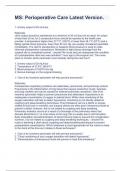
MS: Perioperative Care Latest Version.
MS: Perioperative Care Latest Version.1. Urinary output of 20 mL/hour Rationale: Urine output should be maintained at a minimum of 30 mL/hour for an adult. An output of less than 30 mL for 2 consecutive hours should be reported to the health care provider. A temperature higher than 37.7°C (100°F) or lower than 36.1°C (97°F) and a falling systolic blood pressure, lower than 90 mm Hg, are usually considered reportable immediately. The client's preoperative or baseline blood pressure is u...
- Exam (elaborations)
- • 28 pages •
MS: Perioperative Care Latest Version.1. Urinary output of 20 mL/hour Rationale: Urine output should be maintained at a minimum of 30 mL/hour for an adult. An output of less than 30 mL for 2 consecutive hours should be reported to the health care provider. A temperature higher than 37.7°C (100°F) or lower than 36.1°C (97°F) and a falling systolic blood pressure, lower than 90 mm Hg, are usually considered reportable immediately. The client's preoperative or baseline blood pressure is u...
